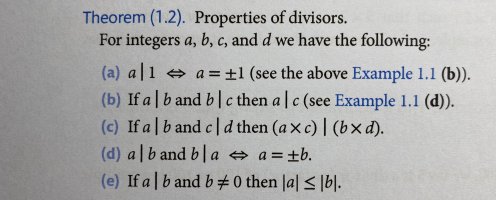I'm self-studying through a number theory book (Singh - Number Theory Step by Step) and I'm having trouble with one of the proofs.
The statement is [imath] If \:(\: a\: | \:b\:) \:and \:( \:c \:| \:d\:) \:then \:(\:ac\:) \:| \:(\: bd\:)[/imath].
I set [imath]\:ax \: = \: b[/imath] and [imath]cy \: = \: d[/imath] for some integers [imath]x, \:y[/imath].
Then substituting [imath]ax[/imath] for [imath]b[/imath] and [imath]cy[/imath] for [imath]d[/imath], I end up with [imath](\: ac \:) | (\:axcy\:)[/imath]. Rearranging I get [imath](\:ac \:) | (\: acxy)[/imath] and [imath](\:ac \:) | (\: ac(xy))[/imath] where [imath]x \times y[/imath] is an integer because x and y are integers.
Dividing both sides by [imath](\:ac \:)[/imath] gives [imath]1\: | (\: xy)[/imath].
The book proceeds differently by [imath](\:ax \times cy \:) | (\: bd \:))[/imath] and [imath](\:ac \times xy \:) | (\: bd \:))[/imath] where xy is the integer.
I know the book method works, but if I were to proceed using my method, where did I go wrong to end up with [imath]1\: | (\: xy)[/imath]?
The statement is [imath] If \:(\: a\: | \:b\:) \:and \:( \:c \:| \:d\:) \:then \:(\:ac\:) \:| \:(\: bd\:)[/imath].
I set [imath]\:ax \: = \: b[/imath] and [imath]cy \: = \: d[/imath] for some integers [imath]x, \:y[/imath].
Then substituting [imath]ax[/imath] for [imath]b[/imath] and [imath]cy[/imath] for [imath]d[/imath], I end up with [imath](\: ac \:) | (\:axcy\:)[/imath]. Rearranging I get [imath](\:ac \:) | (\: acxy)[/imath] and [imath](\:ac \:) | (\: ac(xy))[/imath] where [imath]x \times y[/imath] is an integer because x and y are integers.
Dividing both sides by [imath](\:ac \:)[/imath] gives [imath]1\: | (\: xy)[/imath].
The book proceeds differently by [imath](\:ax \times cy \:) | (\: bd \:))[/imath] and [imath](\:ac \times xy \:) | (\: bd \:))[/imath] where xy is the integer.
I know the book method works, but if I were to proceed using my method, where did I go wrong to end up with [imath]1\: | (\: xy)[/imath]?


